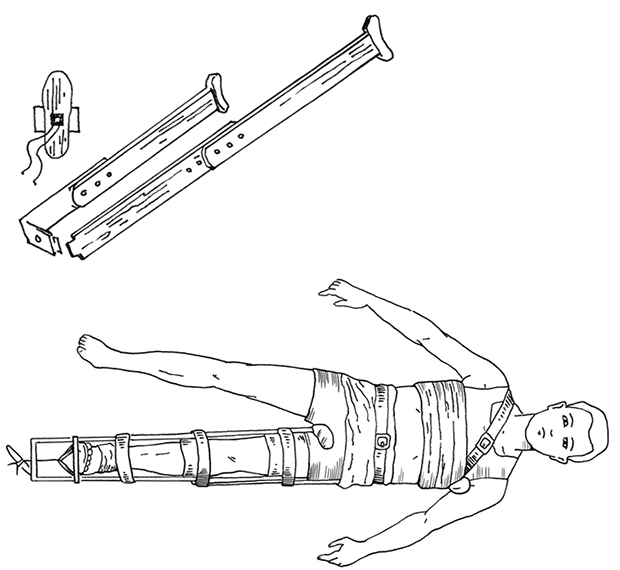DiterikhsMykhailo
November 22, 1871, Odesa, Russian Empire (now Ukraine) —
January 12, 1941, Moscow, USSR (now Russia)
Transportation splints
The thigh bone (femur) is one of the strongest in the skeleton. It takes about 3-4 thousand Newtons to break it somewhere in the middle. It’s like pushing something stationary that weighs

More than a hundred years ago, the situation was the opposite: up to 80 % of injured people died. Despite the lack of such a number of cars as now, and only a few cases of accidents, the chances of getting a fracture of the femur was enought. According to indirect estimates, only in the period from 1914 to 1918, during the First World War, about a million people suffered a femur fracture, caused by the bullets (gun shots) that easily broke thigh bones.
A normal fracture can be fixed even with a cut or broken tree branch, but a femur fracture is not so simple. Any movement or spasm of the muscles, which the attached branch cannot prevent, leads to the fact that the two sharp ends of the broken bone begin to cut blood vessels and other soft tissues inside the thigh. Blood loss can be so great that it causes death.
A solution was needed. And it was found independently (separately) by two surgeons — Hugh Owen Thomas from Britain and Mykhailo Diterikhs from Ukraine.
Both Thomas and Diterikhs offered special transportation splints to military (battlefield) surgeons, which simultaneously fixed the fracture site and extended the leg. This made it possible to stop or at least significantly reduce the bleeding, as the muscles could no longer contract spontaneously and the sharp ends of the broken bone could not move.
Interestingly, Thomas designed the splint in 1875, but the British military paid attention (noticed) to it only in 1916 and began to use it, slightly changing the design(structure).
Diterikhs developed his splint after the end of the First World War in 1923. He understood that first aid was often provided to the wounded by non-professional doctors, so he made it simple to use: even without special training, it could be easily applied, and most importantly — one person could handle it.
The splint consisted of a wooden sole and crutch-like outer and inner wooden parts, which, depending on the height of the victim, were pushed or shifted lengthwise. By attaching the sole to the foot and the wooden parts to the injured leg and torso, the leg could be straightened. It was necessary to pull the rope attached to the sole. Of course, you need to pull carefully and only until the leg is straightened and becomes the same length as healthy one. When the traction and fixation were done, the victim was sent to the hospital.

Dieterich's transportation splints
In 1934, the Diterikhs’ splint began to be used by the Red Army, and during World War II it helped reduce the number of deaths from gunshot wounds to 20 %.
Modern splints for fixation and traction, which are used in both military and civilian medicine, are much lighter and more compact, but the principle of aсtion is almost no different from the prototypes, except that in some splints traction is not made by eye.
However, it is not surprising that a large number of ambulance doctors still continue to use the Diterikhs’ splints of original design, because it still handles well with the task.